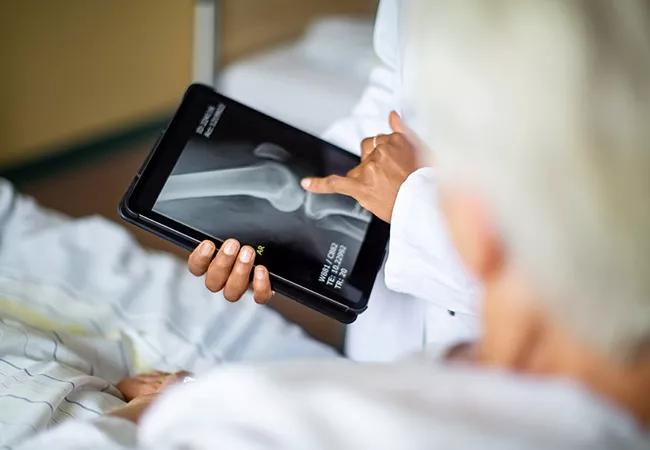Individuals considered frail by medical criteria have higher risks of complications

Advertisement
Cleveland Clinic is a non-profit academic medical center. Advertising on our site helps support our mission. We do not endorse non-Cleveland Clinic products or services. Policy
We know that advanced age is no longer a barrier to undergoing surgery in the U.S. As the population ages, more of our elderly patients are in need of surgical interventions to address health issues – from valve-replacement surgery and hernia repair to cataract removal and joint replacements.
But can a patient be too frail to have a procedure? The surgical literature of the last couple of years has been paying more attention to frailty in older patients. And recently, functional status has been increasingly predictive of how older individuals do after surgery. Individuals who are more functionally independent (e.g., able to do daily living activities independently) are usually more physically and cognitively intact, and those with more limitations are usually more physically and/or cognitively impaired. This functional status is a good marker of overall fitness for surgery.
Years ago, geriatrician Linda Fried, MD, MPH, developed the “frailty phenotype” as a way to characterize and measure this concept. The term “frail” is often used when referring to individuals who are older, more disabled, more dependent on others for assistance or less able to do things independently.
As a medical measurement, meeting criteria for frailty requires three of the following:
This basic definition has been expanded and refined over the years to include other elements, but the underlying premise is the same: identifying individuals whose overall performance is associated with higher risk of complications when they undergo some sort of medical intervention.
Advertisement
Recently, Cleveland Clinic’s Geriatric Center began a collaboration with Cleveland Clinic Anesthesia and Spine Surgery to identify patients 75 and older who may fall into the category of being frail. The collaboration entails referring patients for a geriatric consult before an elective procedure when frailty syndrome is suspected.
We know that certain conditions can slow patients down, from cancer and cardiovascular disease to depression and thyroid disorders. They can all lead to deconditioning, and each patient’s situation is different and must be looked at individually. In addition to the traditional cardiovascular testing to clear patients for an elective surgery, frailty should now be a part of the pre-surgery discussion.
And it is not enough for a physician to briefly examine a patient to make a judgment on frailty. We must have a more in-depth discussion with a patient and look at the above set of criteria to determine true frailty. What is interesting to me is lifestyle choices throughout one’s life that influence nutritional status and physical well-being, which have a significant impact on frailty risk score. Though we often think about diet and exercise as interventions to promote everyday life and healthiness alone, these lifestyle choices influence frailty and the ability to tolerate surgery later in life.
This collaboration with Anesthesia and Spine Surgery is just getting underway and will take some time to yield results, but the important thing is that we are making strides toward doing a more thorough evaluation of elderly patients who are planning elective surgeries.
Advertisement
This is an opportunity to reduce length of stay and re-hospitalizations and improve and optimize outcomes. And while we can’t change a patient’s comorbidities or medicine needs, we can incorporate a more functional measurement. The plan is to have these individuals undergo “prehab” to prepare them for surgery. Considering the frailty criteria above, we are looking at several interventions to see if a person’s frailty score can be reduced, potentially decreasing surgical risk. Interventions to reduce frailty might include physical therapy or an exercise program to address muscle weakness, exhaustion and low physical activity as well as nutrition changes to improve status or stabilize weight.
It’s not yet clear at this time whether interventions implemented immediately before surgery will make a difference, but what we are doing is putting an elective procedure on hold for a few weeks and working with patients to try to improve their endurance.
At Cleveland Clinic, we will continue to look at frailty risks associated with surgical interventions. And as more elderly patients are candidates for elective surgeries, further study on a larger scale will need to be done to provide the best long-term outcomes.
Advertisement
Advertisement

Multidisciplinary approach helps address clinical and psychosocial challenges in geriatric care

Effective screening, advanced treatments can help preserve quality of life

Study suggests inconsistencies in the emergency department evaluation of geriatric patients

Auditory hallucinations lead to unusual diagnosis

How providers can help prevent and address this under-reported form of abuse

How providers can help older adults protect their assets and personal agency

Recognizing the subtle but destructive signs of psychological abuse in geriatric patients

Early screening — and shorter boarding times — benefit older adults